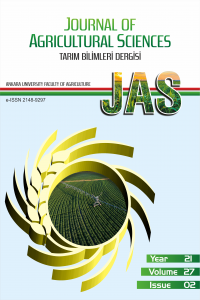Potency of Some Synthetic Stimulants and Root Exudates for Broomrape Control
Zararlı etkilerinin oldukça büyük olmasından dolayı, canavar otları, özellikle Solanaceae ve Fabaceae familyalarına ait bazı kültür bitkilerinin en önemli sorunu olarak değerlendirilmektedir. Phelipanche ramosa L. ve Phelipanche aegyptiaca (L.) Pers. Türkiye’de ve diğer Akdeniz ülkelerinde daha çok domates üretim alanlarında sorun olmaktadır. Bu çalışma bazı bitki kök salgılarının ve sentetik stimulant maddelerin, bu canavar otu türlerinin çimlenme oranına etkisini belirlemek amacıyla kontrollü koşulların sağlandığı laboratuvarlarda yürütülmüştür. Çalışmada sentetik çimlenme stimulantları olarak GR24 (0.1-1 ppm), GR7 (0.1-1 ppm) ve GA3 (10 ppm), kök salgısı olarak keten, pamuk, soya, fasulye, bezelye, börülce, domates, mercimek, hıyar ve tütün fideleri kullanılmıştır. Çalışmadaki sentetik stimulant maddeler, kök salgıları ile ilk kez bu çalışmada karşılaştırılmıştır. Denemelerden elde edilen ortalama sonuçlara göre; sentetik stimulantlar ve kök salgıları 1 yaşındaki P. ramosa çimlenme oranını sırasıyla % 50-77 ve 0 - 16 arasında artırırken, 3 yaşındaki P. aegyptiaca için elde edilen ortalama değerler % 62-95 ve 0-63 arasında olmuştur. Sonuç olarak, sentetik stimulant maddelerin canavar otlarının çimlenme oranını önemli derecede artırdığı belirlenmiştir. Due to their huge harm effects, broomrapes (Orobanche/Phelipanche spp) are considered the biggest problem of some cultivated plants especially belong to Solanaceae and Fabaceae families. Phelipanche ramosa L. and Phelipanche aegyptiaca (L.) Pers. cause big problem especially in tomato grown areas in Turkey and the other Mediterranean countries. This study was conducted to determine the effect of some synthetic stimulant substances and root exudates on the germination rate of the broomrape species in controlled laboratory conditions. In this study GR24 (0.1-1 ppm), GR7 (0.1-1 ppm) and GA3 (10 ppm) were used as synthetic germination stimulants; flax, cotton, soybean, bean, pea, cowpea, tomato, lentil, cucumber and tobacco seedlings were used as exudates. The synthetic stimulants were compared with the root exudates for the first time in this study. As a result of the studies it was determined that synthetic stimulants significantly increase the germination rate of Phelipanche species. According to average results of the trials; synthetic stimulants and root secretions increased the germination rate of P. ramosa at one years of age between 50 - 77 and 0 - 16 respectively, otherwise average datas for P. aegyptiaca at three years of age are between 62 - 95 and 0 - 63. As a result of the studies it was determined that synthetic stimulants were significantly increased the germination rate of Phelipanche species.
Potency of Some Synthetic Stimulants and Root Exudates on the Germination of Phelipanche spp.
Broomrapes (Orobanche/Phelipanche spp.) are considered as the most important problem of some cultivated plants, especially belonging to Solanaceae and Fabaceae families. Phelipanche ramosa L. and Phelipanche aegyptiaca (L.) Pers. cause serious problems especially in tomato grown areas in Turkey and the other Mediterranean countries. This study was conducted to determine the effect of some synthetic stimulant substances and root exudates on the germination rate of the broomrape species under controlled laboratory conditions. GR24 (0.1-1 ppm), GR7 (0.1-1 ppm) and GA3 (10 ppm) were used as synthetic germination stimulant substances; otherwise flax, cotton, soybean, bean, pea, cowpea, tomato, lentil, cucumber and tobacco seedlings were used for root exudates. According to average results of the trials; synthetic stimulants and root secretions increased the germination rate of P. ramosa at the range of 50-77% and 0-16%respectively, otherwise average data for P. aegyptiaca are 62-95% and 0-63%. As a result of the studies it was determined that synthetic stimulants were significantly increased the germination rate of Phelipanche species.
